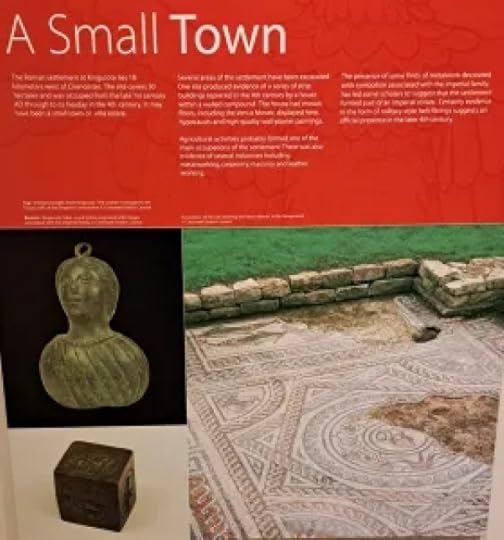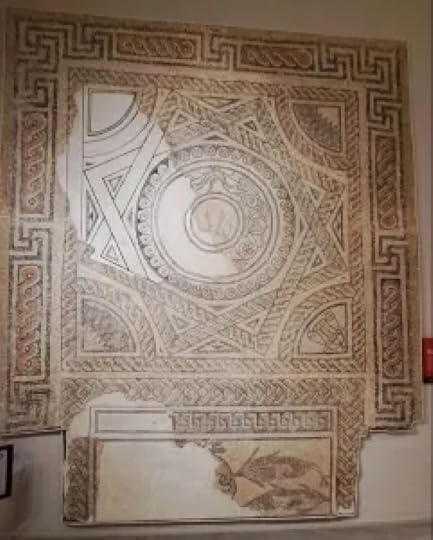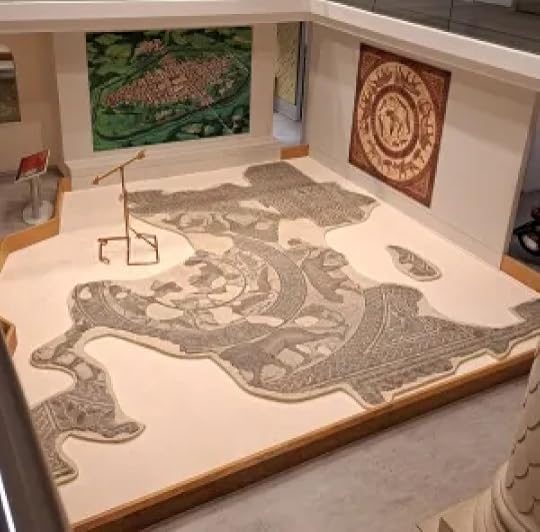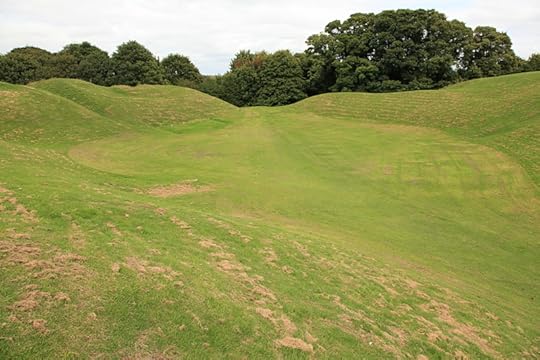When in Corinium…
In my column for the March issue of the Tetbury Advertiser , I describe a fascinating afternoon researching Corinium – the ancient Roman name for what’s now the Cotswold market of Cirencester.
As part of my research for a new novel (the first in a new series), I finally get round to revisiting the Corinium Museum in Cirencester.
I’ve been meaning to do this since it had a major refit 20 years ago. Still, better late than never, and I’m glad my current project has given me the nudge I needed. Cheerful staff give us a warm welcome and invite us to travel back in time to experience the history of the Cotswolds since the earliest days of human settlement.
 Bright, helpful signage tells you just enough to help you appreciate the displays
Bright, helpful signage tells you just enough to help you appreciate the displaysFor the purposes of my novel, I’m particularly keen to see the museum’s extensive display of Roman mosaics, formed from tiny hand-cut tesserae (tiles) of stone and clay and set into intricate patterns by highly skilled craftsmen. Retaining the natural colours of these raw materials, the mosaics are still as bright as they must have been two millennia ago, and as pleasing to modern eyes as to those of the Ancient Romans.
 This vast mosaic is wall-mounted to protect it from 21st century footsteps
This vast mosaic is wall-mounted to protect it from 21st century footstepsMost of the mosaics are either wall-mounted or roped off to prevent visitors traipsing across them, but there’s one small mosaic square that visitors are encouraged to walk on.
“Just think,” says an eager museum volunteer as we stroll across the Meander Maze, “you’re treading exactly where Roman feet once trod.”
 This one reminded me on an incomplete jigsaw puzzle – I was itching to find the space pieces and fill in the gaps!
This one reminded me on an incomplete jigsaw puzzle – I was itching to find the space pieces and fill in the gaps!Her enthusiasm is infectious. In fact, we’re so buoyed up by our close encounter with Cirencester’s ancient forerunner, the city of Corinium Dobunnorum, that on our way home we follow the brown sign off the ring road to the Roman amphitheatre – another local sight I’ve never seen before. Driving past the sign, I’ve always thought, ‘I really must go there some day”. Approaching the historic monument via a pleasant waterside trail, I’m glad I’ve followed through at last.
 Photo accreditation: Site of Roman Amphitheatre, Cirencester by Rob Noble, CC BY-SA 2.0 <https://creativecommons.org/licenses/by-sa/2.0>, via Wikimedia Commons
Photo accreditation: Site of Roman Amphitheatre, Cirencester by Rob Noble, CC BY-SA 2.0 <https://creativecommons.org/licenses/by-sa/2.0>, via Wikimedia CommonsThe amphitheatre, unlike the mosaics, is unprotected from the elements. Although the stonework is no longer in evidence, the giant grassy bowl, slick with mud in the half-term drizzle, is remarkably atmospheric, especially when the younger members of our party decide to play gladiators in the arena.
I return home wishing I hadn’t left it so long before visiting either attraction.
On the other hand, a couple of decades is the blink of an eye compared to the time it took for Corinium Dobunnorum to evolve into modern-day Cirencester.
And the revamped Corinium Museum still looks and feels as fresh and vibrant as it must have done twenty years ago.
I just wish the same could be said for me.
IN OTHER NEWSMy trip to ancient Corinium instilled me with a vivid “sense of place” – the theme for the next Hawkesbury Upton Literature Festival event which I’ll be chairing on Saturday 27th April at St Mary’s, Hawkesbury GL9 1BN, in the company of many local authors of memoir, historical and contemporary fiction. There’ll also be beautiful readings of evocative poetry and prose.
If you’re within easy reach of Hawkesbury, do come and join us. For more information and to book tickets, visit the HULF website or go straight to the Eventbrite booking page.




